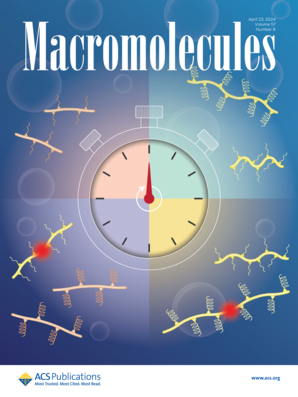Hydrophobic Collapse of a Poly(ethylene Oxide)–Poly(propylene Oxide) Alternating Multiblock Copolymer in Water
IF 5.1
1区 化学
Q1 POLYMER SCIENCE
引用次数: 0
Abstract
The morphology of single chains and micelles formed by a poly(ethylene oxide) (PEO)–poly(propylene oxide) (PPO) alternating multiblock (AMB) copolymer in water was investigated using scattering techniques. Two series of PEO–PPO AMB copolymers, (EO220PO33)n and (EO68PO33)n─where EO and PO represent ethylene oxide and propylene oxide units, respectively, and n denotes the number of repeating PEO–PPO units─were synthesized with varying overall chain lengths while maintaining a 1:1 block ratio of PEO to PPO. Small-angle X-ray scattering (SAXS) and dynamic light scattering revealed that both (EO220PO33)n and (EO68PO33)n adopt a collapsed conformation in water at ambient temperature. Interestingly, the morphology of the AMB copolymers changes with n: in both series, the polymers exhibit increased shrinkage in water as n increases. AMB copolymers possessing longer PEO chains undergo a more pronounced shrinkage. This aligns with the theoretical prediction for the hydrophobic collapse in protein folding [Y. Harano and M. Kinoshita, Biophys. J. 2005, 89, 2701]. As the temperature increases, AMB copolymers associate to form micelles. The SAXS profiles for (EO220PO33)n are independent of n, indicating that the size and morphologies of micelles remain consistent. A similar trend is observed for (EO68PO33)n. These results suggest that the entropy gain of the surrounding water─resulting from the association of a specific number of PPO blocks─compensates for the entropy loss associated with micelle formation.

聚环氧乙烷-聚环氧丙烷交联多嵌段共聚物在水中的疏水崩塌
利用散射技术研究了聚环氧乙烷(PEO) -聚环氧丙烷(PPO)交替多嵌段(AMB)共聚物在水中形成的单链和胶束形态。合成了两个系列的PEO - PPO AMB共聚物(EO220PO33)n和(EO68PO33)n,其中EO和PO分别代表环氧乙烷和环氧丙烷单元,n表示重复PEO - PPO单元的数量,它们具有不同的总链长,同时PEO与PPO的嵌段比保持1:1。小角x射线散射(SAXS)和动态光散射结果表明,(EO220PO33)n和(EO68PO33)n在常温下均呈塌缩构象。有趣的是,AMB共聚物的形态随n的变化而变化:在两个系列中,随着n的增加,聚合物在水中的收缩率增加。具有更长的PEO链的AMB共聚物具有更明显的收缩。这与蛋白质折叠中疏水崩溃的理论预测一致[Y]。哈拉诺和木下,《生物物理学》。[j].环境科学学报,2003,19(2):391 - 391。随着温度的升高,AMB共聚物缔合形成胶束。(EO220PO33)n的SAXS谱与n无关,表明胶束的大小和形态保持一致。(EO68PO33)n也有类似的趋势。这些结果表明,由于特定数量的PPO块的结合,周围水的熵增益补偿了与胶束形成相关的熵损失。
本文章由计算机程序翻译,如有差异,请以英文原文为准。
求助全文
约1分钟内获得全文
求助全文
来源期刊

Macromolecules
工程技术-高分子科学
CiteScore
9.30
自引率
16.40%
发文量
942
审稿时长
2 months
期刊介绍:
Macromolecules publishes original, fundamental, and impactful research on all aspects of polymer science. Topics of interest include synthesis (e.g., controlled polymerizations, polymerization catalysis, post polymerization modification, new monomer structures and polymer architectures, and polymerization mechanisms/kinetics analysis); phase behavior, thermodynamics, dynamic, and ordering/disordering phenomena (e.g., self-assembly, gelation, crystallization, solution/melt/solid-state characteristics); structure and properties (e.g., mechanical and rheological properties, surface/interfacial characteristics, electronic and transport properties); new state of the art characterization (e.g., spectroscopy, scattering, microscopy, rheology), simulation (e.g., Monte Carlo, molecular dynamics, multi-scale/coarse-grained modeling), and theoretical methods. Renewable/sustainable polymers, polymer networks, responsive polymers, electro-, magneto- and opto-active macromolecules, inorganic polymers, charge-transporting polymers (ion-containing, semiconducting, and conducting), nanostructured polymers, and polymer composites are also of interest. Typical papers published in Macromolecules showcase important and innovative concepts, experimental methods/observations, and theoretical/computational approaches that demonstrate a fundamental advance in the understanding of polymers.
 求助内容:
求助内容: 应助结果提醒方式:
应助结果提醒方式:


